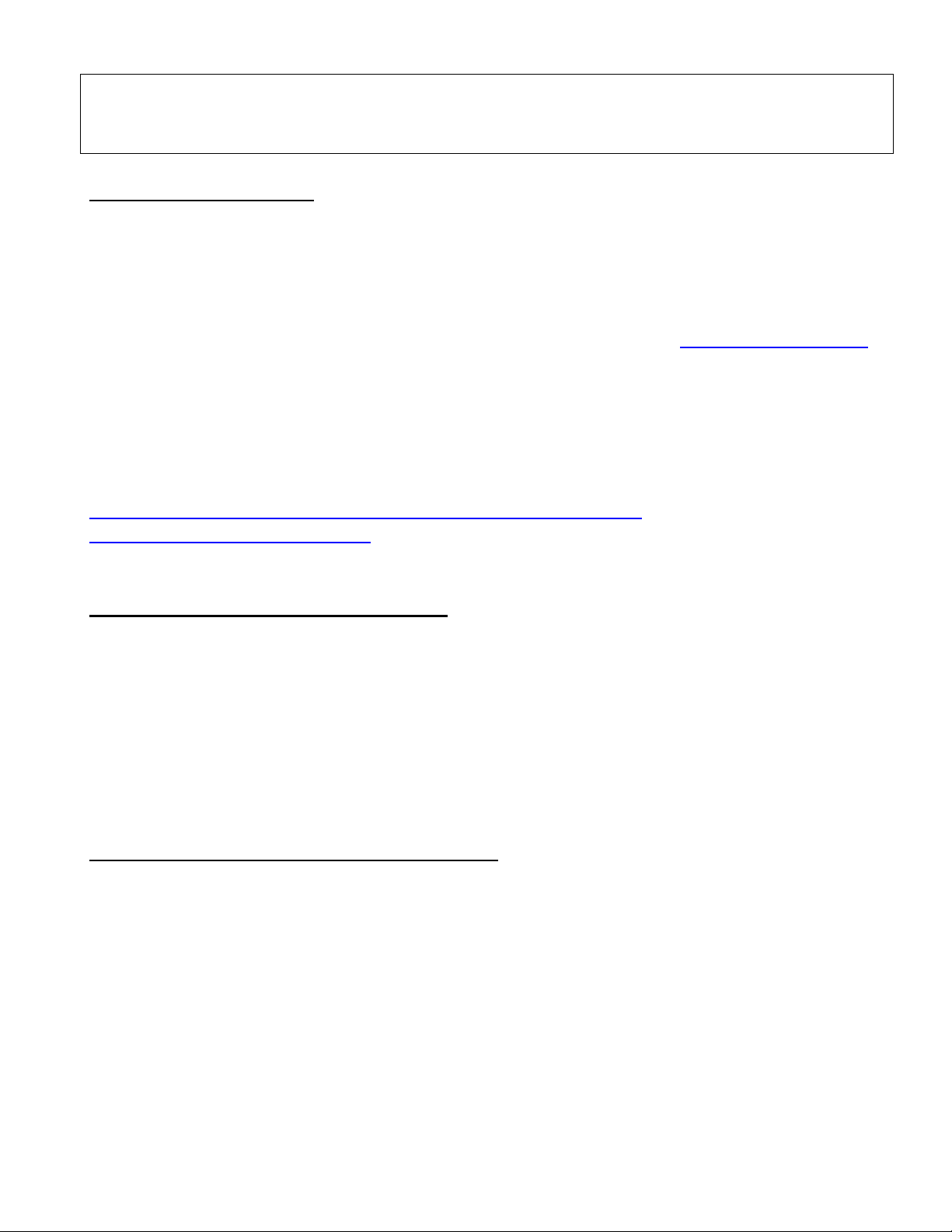
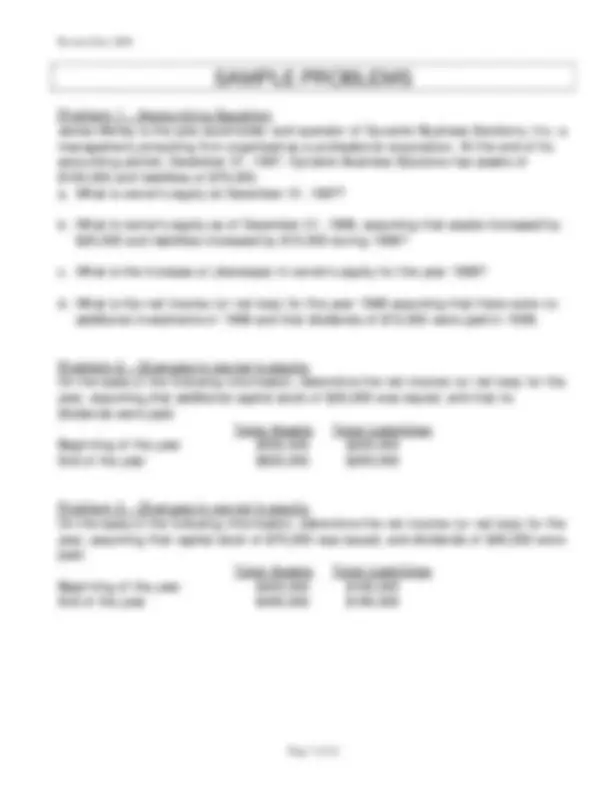
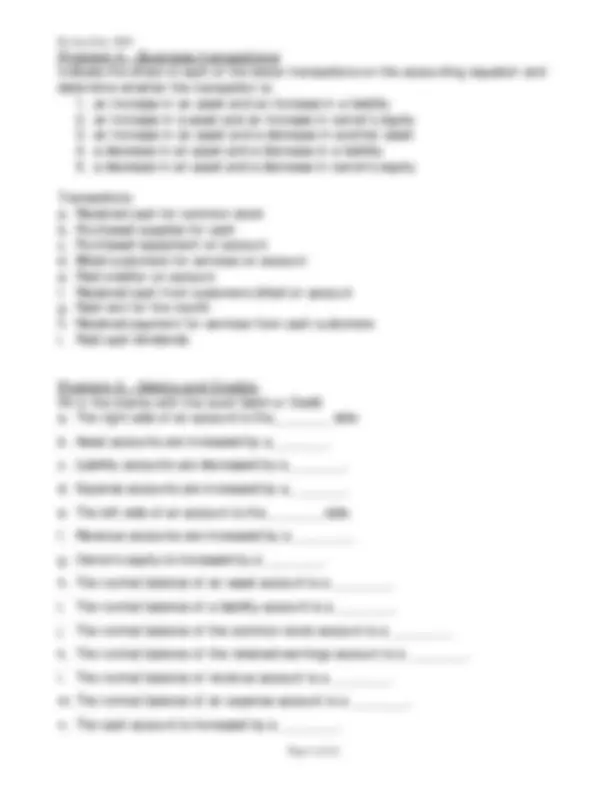
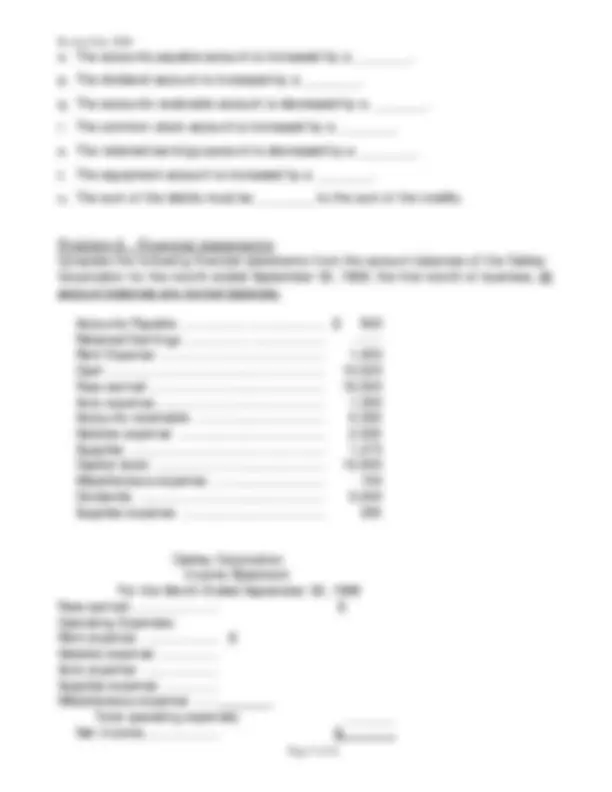
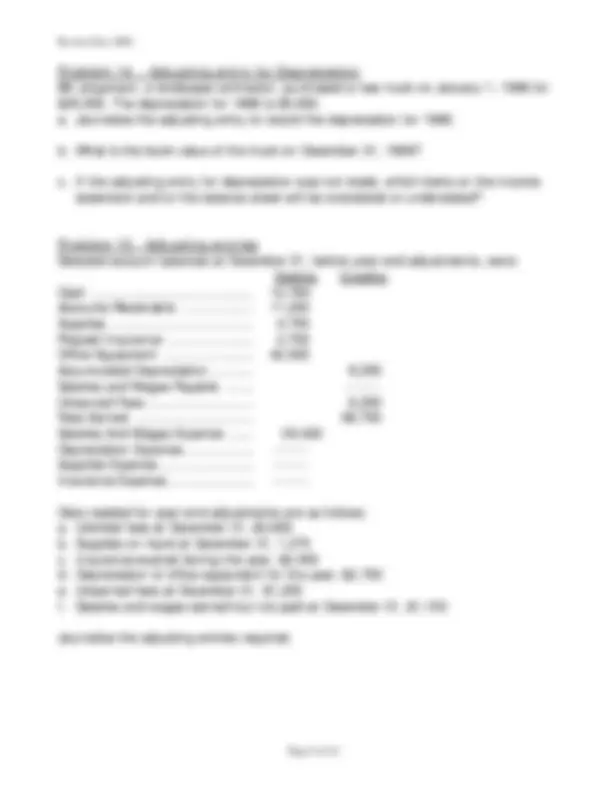
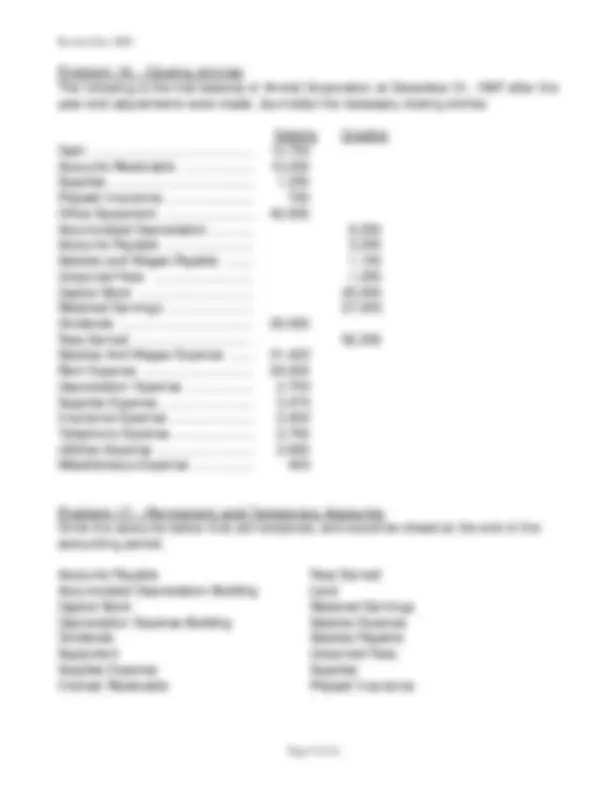
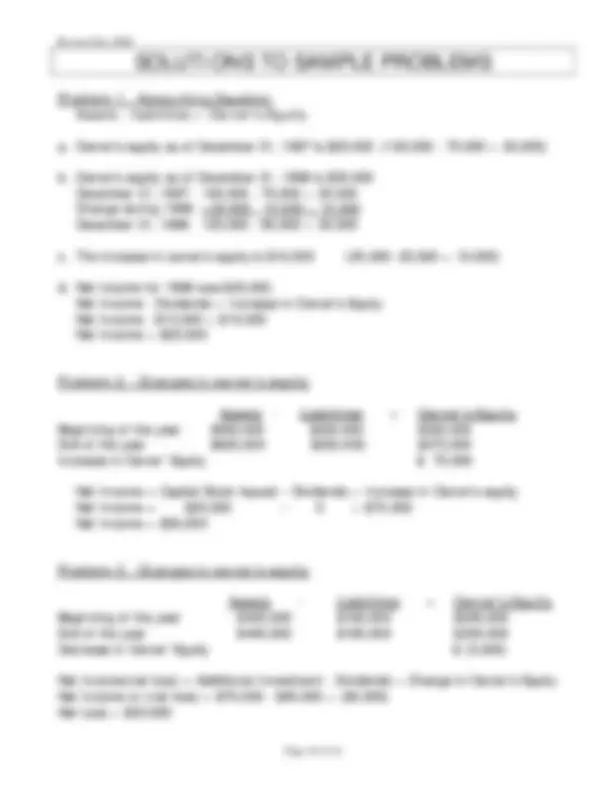
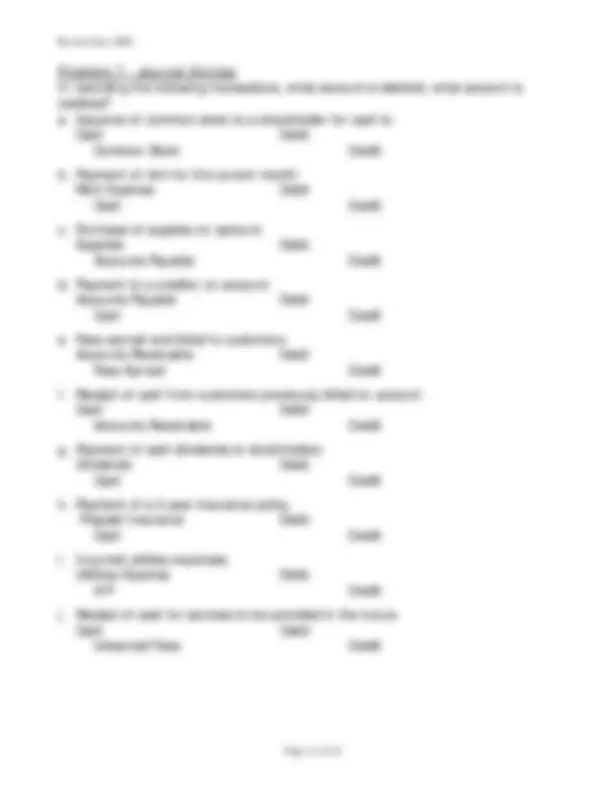
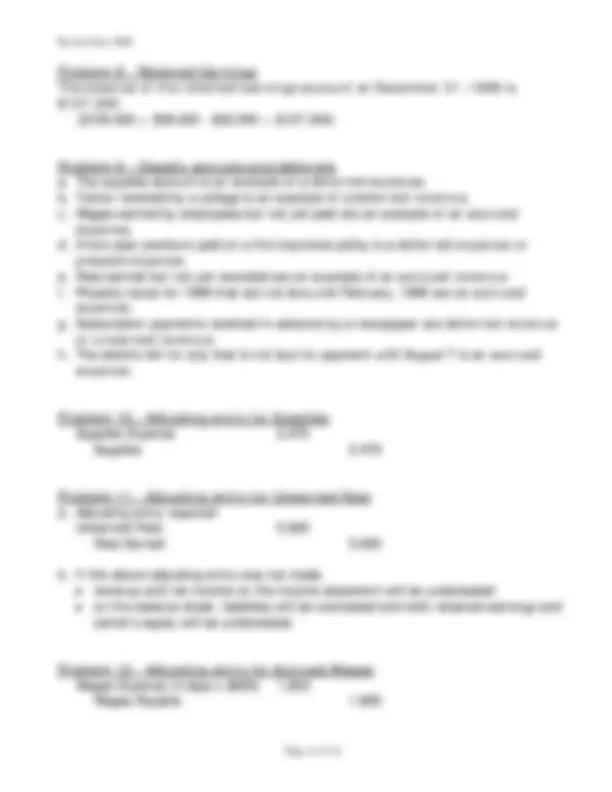
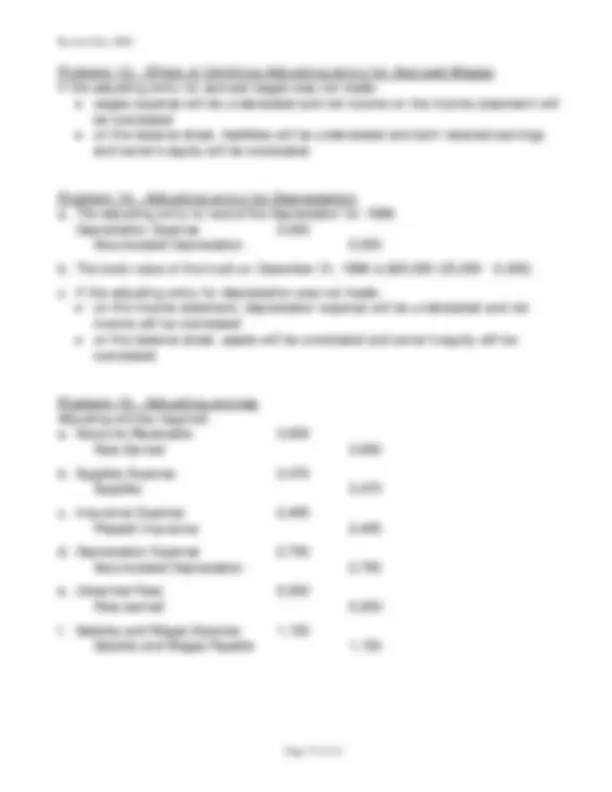


Study with the several resources on Docsity

Earn points by helping other students or get them with a premium plan


Prepare for your exams
Study with the several resources on Docsity

Earn points to download
Earn points by helping other students or get them with a premium plan
Community
Ask the community for help and clear up your study doubts
Discover the best universities in your country according to Docsity users
Free resources
Download our free guides on studying techniques, anxiety management strategies, and thesis advice from Docsity tutors
Material Type: Notes; Class: INTRODUCTION TO FINANCIAL ACCOUNTING; Subject: Accounting; University: Harper College; Term: Unknown 2008;
Typology: Study notes
1 / 16

This page cannot be seen from the preview
Don't miss anything!










Review your class notes, homework exercises and problems. Be sure to review any chapter appendicies assigned on the General Course Outline. Review Demonstration Problem, Summary and Key Terms at the end of each chapter. Answer the Multiple Choice Quiz at the end of each chapter. Answer Multiple Choice Quiz A and B on the textbook website www.mhhe.com/wild. Know accounting terms and concepts by answering the Discussion Questions at the end of each chapter. Know the account classification (i.e. asset, liability, or owner's equity) and normal balance of all accounts. Know the what the financial ratios mean and how to calculate them. Other online help is available ay a variety of sites such as: http://www.cliffsnotes.com/WileyCDA/Section/id-305261.html http://www.simplestudies.com/
Chapter 1 – Accounting in Business Understand the accounting equation and its three basic elements. Know how business transactions affect the three basic elements in the accounting equation. Know which accounts are income statement accounts, how to prepare an income statement and how to calculate net income without preparing an income statement. Know how to prepare a retained earnings statement. Understand which accounts are balance sheet accounts and be able to prepare a balance sheet.
Chapter 2 – Accounting for Transactions Know what a journal is and what it is used for. Know what a ledger is and what it is used for. Know what a chart of accounts is and what it is used for. Know the rules of Debit and Credit and the normal balances of accounts: Debit is the left side of an account and Credit is the right side of an account
Normal Balance Normal Balance Increase Decrease Increase Decrease
Asset Debit Credit Revenue Credit Debit Liability Credit Debit Expense Debit Credit Owner's Equity Capital Stock Credit Debit Retained Earnings Credit Debit Dividends Debit Credit
Know how to journalize transactions , including which accounts to debit and credit, for the various types of transactions. Know how to prepare a trial balance and correct any errors.
Chapter 3 – Preparing Financial Statements Understand the matching concept and how it relates to accrual accounting. Know how to classify items as: deferred expenses (prepaid expenses) deferred revenues (unearned revenues) accrued expenses (accrued liabilities) accrued revenues (accrued assets) Know how to journalize adjusting entries and understand their characteristics. Know what the effects on the financial statements will be if adjusting entries are omitted. Know how to journalize closing entries. Understand the basic steps in the accounting cycle. Know how to prepare a post-closing trial balance, which accounts should and should not appear on it and why it is a necessary step in the accounting cycle.
Problem 4 - Business transactions Indicate the effect of each of the below transactions on the accounting equation and determine whether the transaction is:
Transactions: a. Received cash for common stock b. Purchased supplies for cash c. Purchased equipment on account d. Billed customers for services on account e. Paid creditor on account f. Received cash from customers billed on account g. Paid rent for the month h. Received payment for services from cash customers i. Paid cash dividends
Problem 5 - Debits and Credits Fill in the blanks with the word Debit or Credit a. The right side of an account is the________ side.
b. Asset accounts are increased by a________.
c. Liability accounts are decreased by a________.
d. Expense accounts are increased by a________.
e. The left side of an account is the________ side.
f. Revenue accounts are increased by a ________.
g. Owner's equity is increased by a ________.
h. The normal balance of an asset account is a ________.
i. The normal balance of a liability account is a ________.
j. The normal balance of the common stock account is a ________.
k. The normal balance of the retained earnings account is a ________.
l. The normal balance of revenue account is a ________.
m. The normal balance of an expense account is a ________.
n. The cash account is increased by a ________.
o. The accounts payable account is increased by a ________.
p. The dividend account is increased by a ________.
q. The accounts receivable account is decreased by a ________.
r. The common stock account is increased by a ________.
s. The retained earnings account is decreased by a ________.
t. The equipment account is increased by a ________.
u. The sum of the debits must be ________ to the sum of the credits.
Problem 6 - Financial statements Complete the following financial statements from the account balances of the Oakley Corporation for the month ended September 30, 1998, the first month of business. All account balances are normal balances.
Accounts Payable ................. ................... $ 500 Retained Earnings ................. .................. ------ Rent Expense .......................................... 1, Cash ....................................................... 10, Fees earned ............................................ 16, Auto expense .......................................... 1, Accounts receivable ................................. 5, Salaries expense ..................................... 2, Supplies ................................................. 1, Capital stock ........................................... 10, Miscellaneous expense ............................. 150 Dividends ............................................... 5, Supplies expense .................................... 350
Oakley Corporation Income Statement For the Month Ended September 30, 1998 Fees earned ...................... $ Operating Expenses: Rent expense ................... $ Salaries expense ............... Auto expense ................... Supplies expense .............. Miscellaneous expense ...... Total operating expenses _______ Net Income................... $.
Problem 9 - Classify accruals and deferrals Classify the following items as deferred expenses (prepaid expenses), deferred revenues (unearned revenues), accrued expenses (accrued liabilities) or accrued revenues (accrued assets):
a. The supplies account is an example of a ____________.
b. Tuition received by a college is an example of ____________.
c. Wages earned by employees but not yet paid are an example of an ____________.
d. A two year premium paid on a fire insurance policy is a ____________.
e. Fees earned but not yet recorded are an example of an ____________.
f. Property taxes for 1998 that are not due until February, 1999 are ____________.
g. Subscription payments received in advance by a newspaper are ____________.
h. An electric bill for July that is not due until August 7 is an ____________.
Problem 10 - Adjusting entry for Supplies The balance of the Supplies account before adjustment at the end of the year, is $2,730. Journalize the adjusting entry required if the amount of supplies on hand at the end of the year is $260.
Problem 11 - Adjusting entry for Unearned Fees The balance of the Unearned Fees account before adjustment is $7,300.
a. Journalize the adjusting entry required if the amount of unearned fees at the end of the year is $1,700.
b. If the adjusting entry for unearned fees was not made, which items on the income statement and/or the balance sheet will be overstated or understated?
Problem 12 - Adjusting entry for Accrued Wages Doctor Smith pays his staff weekly every Friday. The weekly wages average $3,000. Journal the adjusting entry required if the accounting period ends on Wednesday.
Problem 13 - Effect of Omitting Adjusting entry for Accrued Wages Doctor Jones, a professional corporation, owed his staff $3,500 for wages earned but not yet paid on December 31. Which items on the income statement and/or the balance sheet will be overstated or understated?
Problem 14 - Adjusting entry for Depreciation Bill Jorgenson, a landscape contractor, purchased a new truck on January 1, 1998 for $25,000. The depreciation for 1998 is $5,000. a. Journalize the adjusting entry to record the depreciation for 1998.
b. What is the book value of the truck on December 31, 1998?
c. If the adjusting entry for depreciation was not made, which items on the income statement and/or the balance sheet will be overstated or understated?
Problem 15 - Adjusting entries Selected account balances at December 31, before year-end adjustments, were: Debits Credits Cash ......................................... 12, Accounts Receivable .................. 11, Supplies .................................... 4, Prepaid Insurance ...................... 2, Office Equipment ....................... 42, Accumulated Depreciation ........... 8, Salaries and Wages Payable ....... -------- Unearned Fees ........................... 6, Fees Earned .............................. 89, Salaries And Wages Expense ....... 29, Depreciation Expense .................. -------- Supplies Expense ........................ -------- Insurance Expense...................... --------
Data needed for year-end adjustments are as follows: a. Unbilled fees at December 31, $3, b. Supplies on hand at December 31, 1, c. Insurance expired during the year, $2, d. Depreciation of office equipment for the year, $2, e. Unearned fees at December 31, $1, f. Salaries and wages earned but not paid at December 31, $1,
Journalize the adjusting entries required.
Problem 1 - Accounting Equation Assets - liabilities = Owner's Equity
a. Owner's equity as of December 31, 1997 is $25,000 (100,000 - 75,000 = 25,000)
b. Owner's equity as of December 31, 1998 is $35, December 31, 1997: 100,000 - 75,000 = 25, Change during 1998: +25,000 - 15.000 = 10, December 31, 1998: 125,000 - 90,000 = 35,
c. The increase in owner's equity is $10,000 (35,000 -25,000 = 10,000)
d. Net income for 1998 was $25,000. Net Income - Dividends = Increase in Owner's Equity Net Income - $15,000 = $10, Net Income = $25,
Problem 2 - Changes in owner's equity
Assets - Liabilities = Owner's Equity Beginning of the year $500,000 $200,000 $300, End of the year $625,000 $250,000 $375, Increase in Owner' Equity $ 75,
Net Income + Capital Stock Issued – Dividends = Increase in Owner's equity Net Income + $25,000 – 0 = $75, Net Income = $50,
Problem 3 - Changes in owner's equity
Assets - Liabilities = Owner's Equity Beginning of the year $425,000 $165,000 $260, End of the year $440,000 $185,000 $255, Decrease in Owner' Equity $ (5,000)
Net Income(net loss) + Additional Investment - Dividends = Change in Owner's Equity Net Income or (net loss) + $70,000 - $45,000 = ($5,000) Net Loss = $30,
Problem 4 - Business transactions a. Received cash for common stock
2. an increase in an asset and an increase in owner's equity b. Purchased supplies for cash 3. an increase in an asset and a decrease in another asset c. Purchased equipment on account 1. an increase in an asset and an increase in a liability d. Billed customers for services on account 2. an increase in a asset and a increase in owner's equity e. Paid creditor on account 4. a decrease in an asset and a decrease in a liability f. Received cash from customers on account 3. an increase in an asset and a decrease in another asset g. Paid rent for the month 5. a decrease in an asset and a decrease in owner's equity h. Received payment for services from cash customers 2. an increase in an asset and an increase in owner's equity i. Paid cash dividends 5. a decrease in an asset and a decrease in owner's equity
Problem 5 - Debits and Credits a. The right side of an account is the credit side. b. Asset accounts are increased by a debit. c. Liability accounts are decreased by a debit. d. Expense accounts are increased by a debit. e. The left side of an account is the debit side. f. Revenue accounts are increased by a credit. g. Owner's equity is increased by a credit. h. The normal balance of an asset account is a debit. i. The normal balance of a liability account is a credit. j. The normal balance of the common stock account is a credit. k. The normal balance of the retained earnings account is a credit. l. The normal balance of revenue account is a credit. m. The normal balance of an expense account is a debit. n. The cash account is increased by a debit. o. The accounts payable account is increased by a credit. p. The dividend account is increased by a debit. q. The accounts receivable account is decreased by a credit. r. The common stock account is increased by a credit. s. The retained earnings account is decreased by a debit. t. The equipment account is increased by a debit. u. The sum of the debits must be equal to the sum of the credits.
Problem 7 - Journal Entries In recording the following transactions, what account is debited, what account is credited? a. Issuance of common stock to a shareholder for cash is: Cash Debit Common Stock Credit
b. Payment of rent for the current month: Rent Expense Debit Cash Credit
c. Purchase of supplies on account: Supplies Debit Accounts Payable Credit
d. Payment to a creditor on account: Accounts Payable Debit Cash Credit
e. Fees earned and billed to customers: Accounts Receivable Debit Fees Earned Credit
f. Receipt of cash from customers previously billed on account: Cash Debit Accounts Receivable Credit
g. Payment of cash dividends to stockholders: Dividends Debit Cash Credit
h. Payment of a 3-year insurance policy. Prepaid Insurance Debit Cash Credit
i. Incurred utilities expenses. Utilities Expense Debit A/P Credit
j. Receipt of cash for services to be provided in the future. Cash Debit Unearned Fees Credit
Problem 8 - Retained Earnings The balance of the retained earnings account at December 31, 1998 is $127,000. ($100,500 + $58,500 - $32,000 = $127,000)
Problem 9 - Classify accruals and deferrals a. The supplies account is an example of a deferred expense. b. Tuition received by a college is an example of a deferred revenue. c. Wages earned by employees but not yet paid are an example of an accrued expense. d. A two year premium paid on a fire insurance policy is a deferred expense or prepaid expense. e. Fees earned but not yet recorded are an example of an accrued revenue. f. Property taxes for 1998 that are not due until February, 1999 are an accrued expense. g. Subscription payments received in advance by a newspaper are deferred revenue or unearned revenue. h. The electric bill for July that is not due for payment until August 7 is an accrued expense.
Problem 10 - Adjusting entry for Supplies Supplies Expense 2, Supplies 2,
Problem 11 - Adjusting entry for Unearned Fees a. Adjusting entry required: Unearned Fees 5, Fees Earned 5,
b. If the above adjusting entry was not made
Problem 12 - Adjusting entry for Accrued Wages Wages Expense (3 days x $600) 1, Wages Payable 1,
Problem 16 - Closing entries Fees Earned 92, Income Summary 92, Income Summary 69, Salaries And Wages Expense 31, Rent Expense 24, Depreciation Expense 2, Supplies Expense 3, Insurance Expense 2, Telephone Expense 2, Utilities Expense 2, Miscellaneous Expense 405
Income Summary 22, Retained Earnings 22,
Retained Earnings 20, Dividends 20,
Problem 17 - Permanent and Temporary Accounts The following accounts are temporary and would be closed: Depreciation Expense-Building Dividends Supplies Expense Fees Earned Salaries Expense